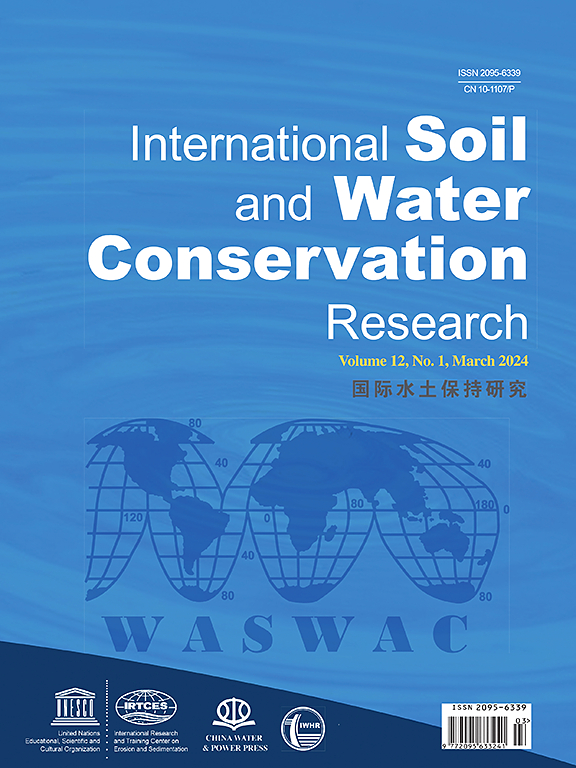Fingerprinting using compound-specific δ13C of n-alkanes reveals the temporary role of paddy fields as a secondary source for watershed sediment loss
IF 7.3
1区 农林科学
Q1 ENVIRONMENTAL SCIENCES
International Soil and Water Conservation Research
Pub Date : 2025-07-09
DOI:10.1016/j.iswcr.2025.07.005
引用次数: 0
Abstract
Fingerprinting generates reliable sediment provenance information which supports devising policy or practical strategies for soil conservation and sediment management, but it remains challenging in areas with fragmented landscapes and diverse land use practices. This study evaluated the seasonality of biomarker signatures and their variability among particle size fractions, and apportioned target time-integrated suspended sediment to land use-based sources in an intensive agricultural watershed with mosaic land use patch configurations and crop-specific farming practices. Source materials (i.e., topsoil) from dry croplands, paddy fields and citrus orchards were sampled, and target time-integrated suspended sediment samples were collected at the watershed outlet. The content and compound-specific δ13C of long-chain saturated n-alkanes (C23-C33) were determined for two particle size fractions (i.e., <25 μm, 25–63 μm). The δ13C of monomeric n-alkanes displayed insignificant variabilities between particle size fractions and temporal variability across the sampling period. The MixSIAR Bayesian model was employed to quantify sediment source contributions. Due to land disturbance by tillage and crop plantation, our results revealed that paddy fields act as an important temporary secondary sediment source despite such fields conventionally being recognized as sediment sinks. Regardless, dry farmland remains the largest contributor to watershed sediment loss. A range of measures such as soil virginization, returning straw to fields, and pasture cultures in orchards are recommended for precision sediment management at watershed scale.
正构烷烃δ13C指纹图谱揭示了水田作为流域沉积物损失的次要来源的暂时作用
指纹识别技术可以提供可靠的沉积物来源信息,为土壤保持和沉积物管理制定政策或实用策略提供支持,但在景观破碎和土地利用方式多样化的地区,指纹识别技术仍然具有挑战性。本研究评估了生物标志物特征的季节性及其在粒度组分之间的变异性,并在具有马赛克土地利用斑块配置和作物特定耕作方式的集约化农业流域中将目标时间积分悬浮沉积物分配到基于土地利用的来源。对旱地、水田和柑橘园的源物质(即表土)进行采样,并在流域出口收集目标时间积分悬浮沉积物样本。测定了长链饱和正构烷烃(C23-C33)在25 μm、25 - 63 μm两个粒径段的含量和化合物特异性δ13C。单体正构烷烃的δ13C在不同粒径组分和时间变异间的变化不显著。采用MixSIAR贝叶斯模型量化泥沙源贡献。由于耕作和种植对土地的干扰,我们的研究结果表明,稻田是一个重要的临时次生沉积物来源,尽管它通常被认为是沉积物的汇。无论如何,干旱农田仍然是流域沉积物流失的最大原因。建议采取一系列措施,如土壤处女化、秸秆还田和果园牧场培养,以实现流域尺度的精确泥沙管理。
本文章由计算机程序翻译,如有差异,请以英文原文为准。
求助全文
约1分钟内获得全文
求助全文
来源期刊

International Soil and Water Conservation Research
Agricultural and Biological Sciences-Agronomy and Crop Science
CiteScore
12.00
自引率
3.10%
发文量
171
审稿时长
49 days
期刊介绍:
The International Soil and Water Conservation Research (ISWCR), the official journal of World Association of Soil and Water Conservation (WASWAC) http://www.waswac.org, is a multidisciplinary journal of soil and water conservation research, practice, policy, and perspectives. It aims to disseminate new knowledge and promote the practice of soil and water conservation.
The scope of International Soil and Water Conservation Research includes research, strategies, and technologies for prediction, prevention, and protection of soil and water resources. It deals with identification, characterization, and modeling; dynamic monitoring and evaluation; assessment and management of conservation practice and creation and implementation of quality standards.
Examples of appropriate topical areas include (but are not limited to):
• Conservation models, tools, and technologies
• Conservation agricultural
• Soil health resources, indicators, assessment, and management
• Land degradation
• Sustainable development
• Soil erosion and its control
• Soil erosion processes
• Water resources assessment and management
• Watershed management
• Soil erosion models
• Literature review on topics related soil and water conservation research
 求助内容:
求助内容: 应助结果提醒方式:
应助结果提醒方式:


